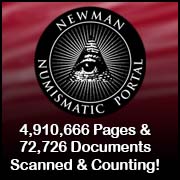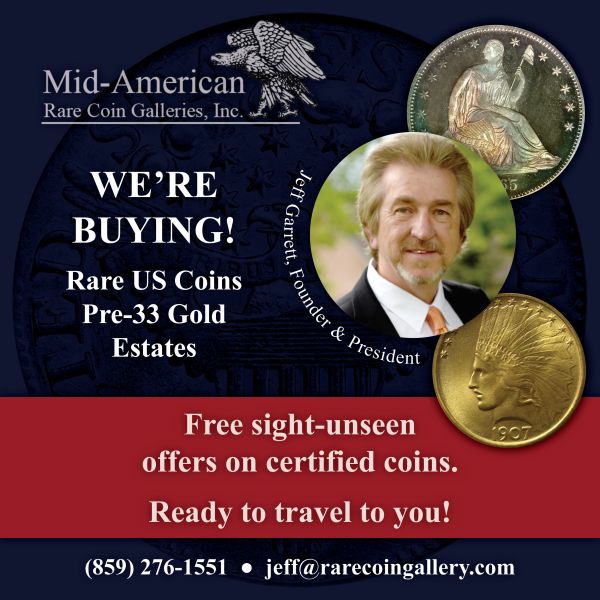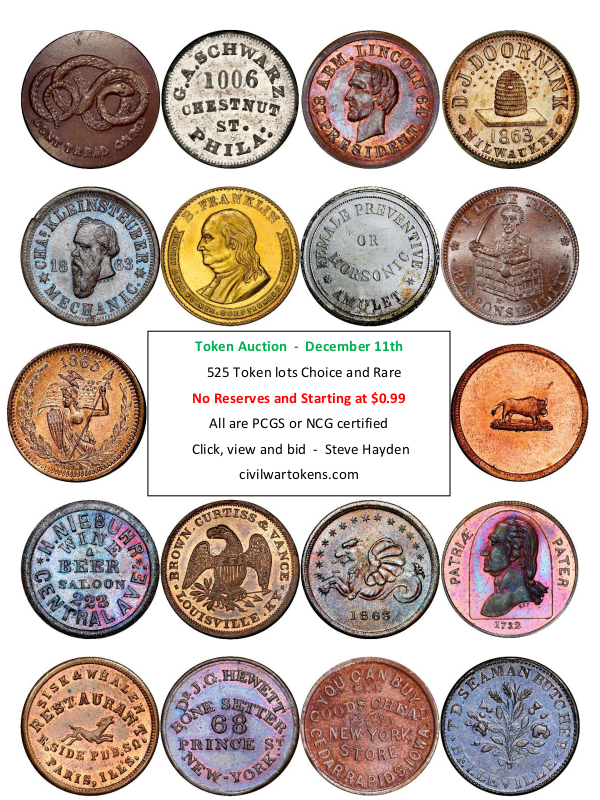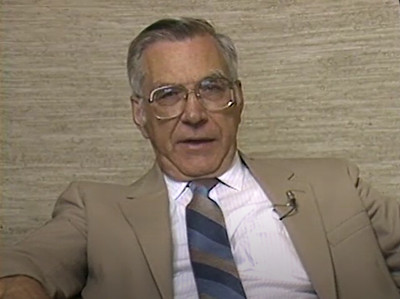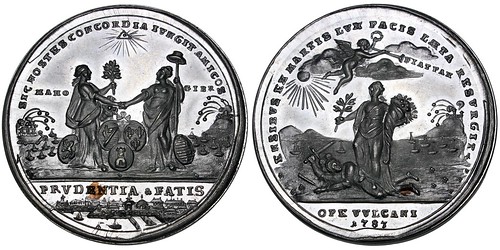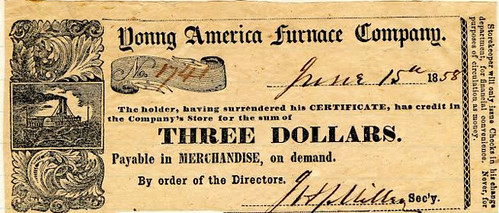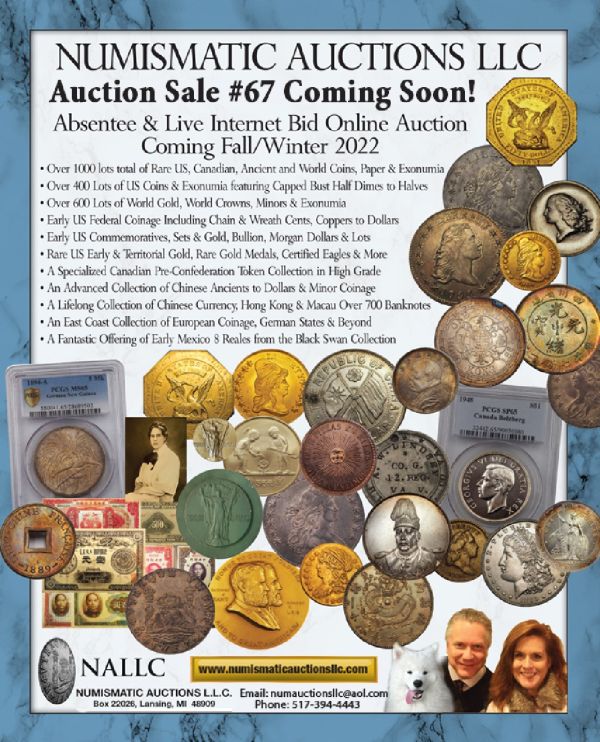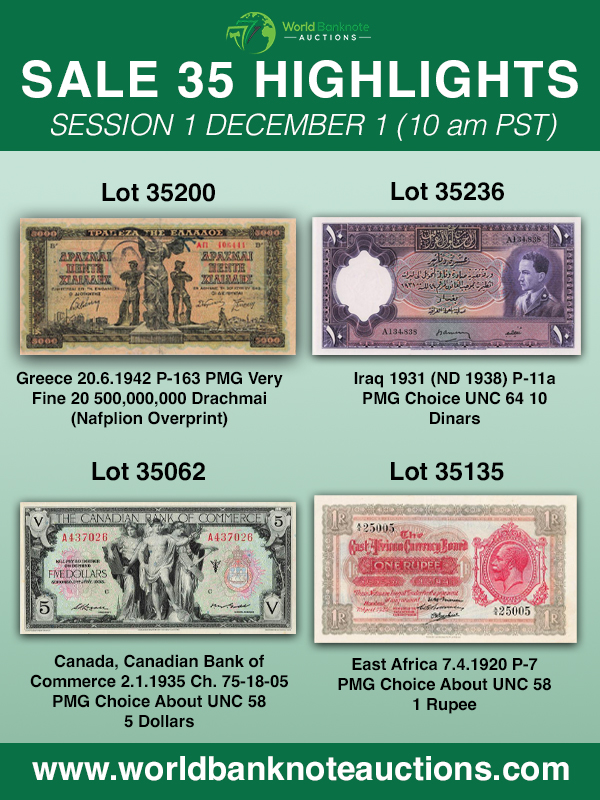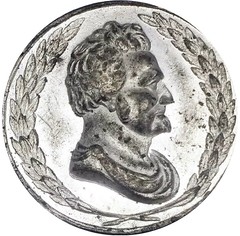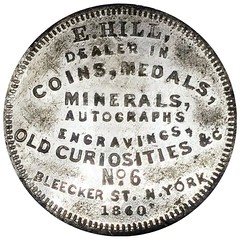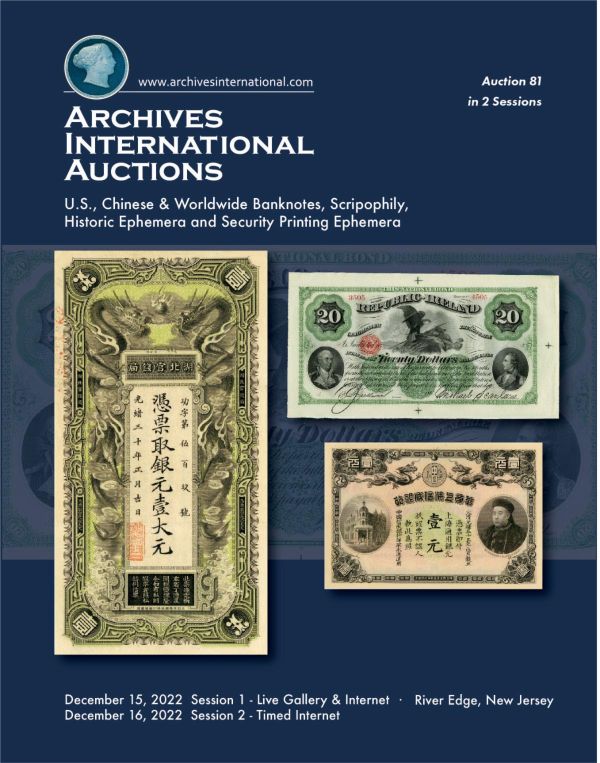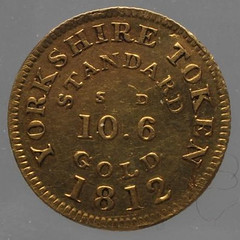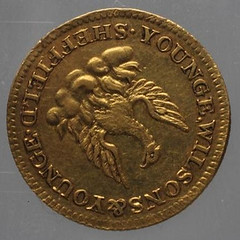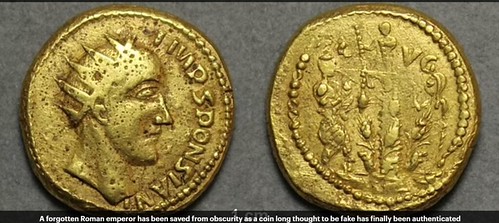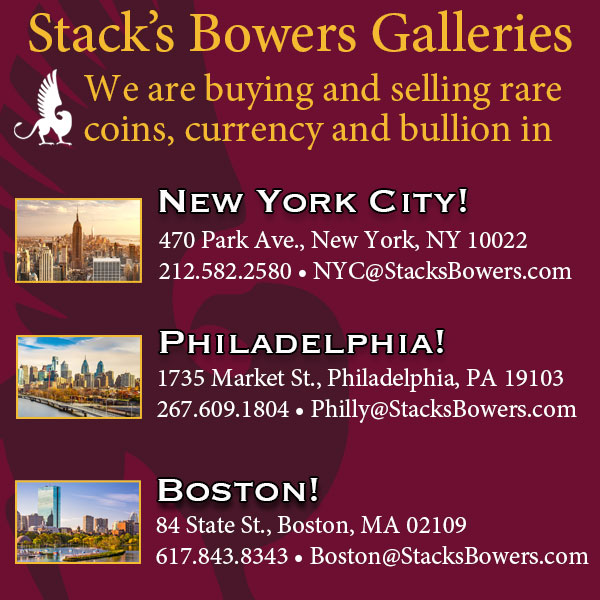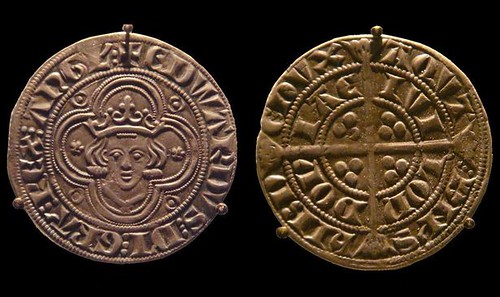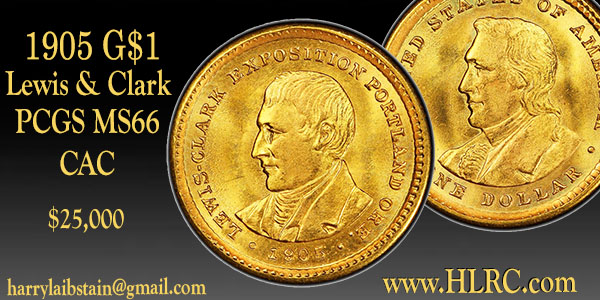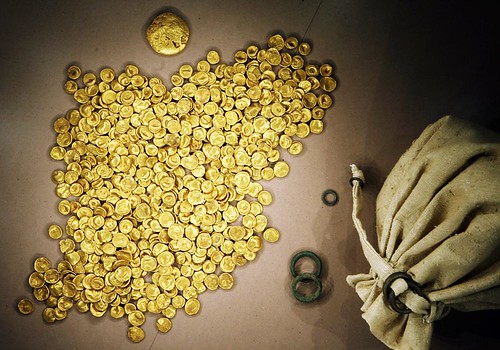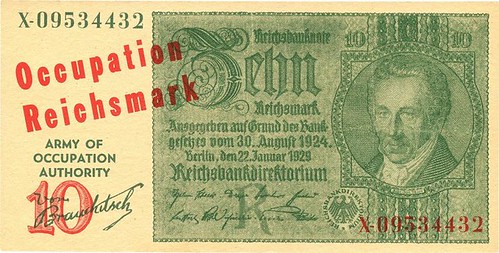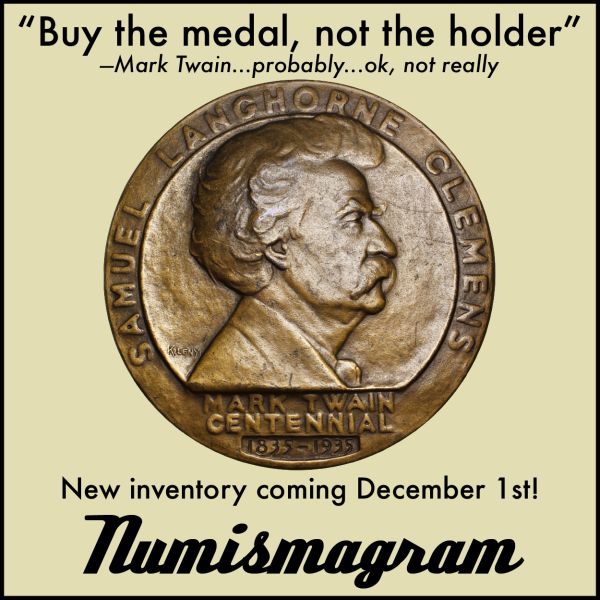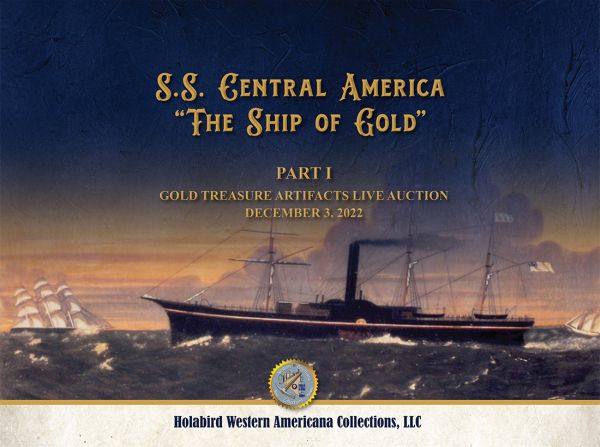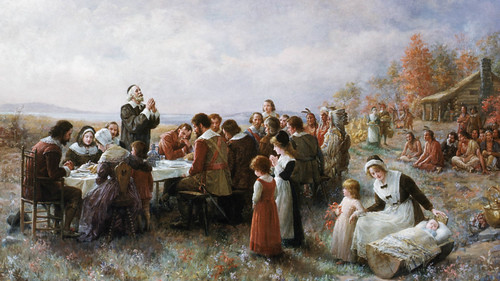
Visit our NBS Sponsors




About UsThe Numismatic Bibliomania Society is a non-profit association devoted to the study and enjoyment of numismatic literature. For more information please see our web site at coinbooks.org SubscriptionsThose wishing to become new E-Sylum subscribers (or wishing to Unsubscribe) can go to the following web page link MembershipThere is a membership application available on the web site Membership Application To join, print the application and return it with your check to the address printed on the application. Print/Digital membership is $40 to addresses in the U.S., and $60 elsewhere. A digital-only membership is available for $25. For those without web access, write to: Charles Heck, Treasurer AsylumFor Asylum mailing address changes and other membership questions, contact Chuck at this email address: treasurer@coinbooks.org SubmissionsTo submit items for publication in The E-Sylum, write to the Editor at this address: whomren@gmail.com BUY THE BOOK BEFORE THE COINSale Calendar |
- WAYNE'S WORDS: THE E-SYLUM NOVEMBER 27, 2022
- E-SYLUM SUBSCRIBER CONTEST REMINDER
- MORE KOLBE & FANNING SALE 165 HIGHLIGHTS
- NEW BOOK: THE EARLY BETTS MEDAL COMPANION
- NEW BOOK: INTERPRETING EARLY MEDIEVAL COINAGE
- NEW BOOK: SASANIAN COINS
- DOUGLAS EARL SPANGLER JR. (1946-2022)
- MORE ON THE CARNEGIE COLLECTION
- VIDEO: CHESTER KRAUSE
- MORE ON THE TREATY OF PARIS MEDAL
- RESPONSE TO THE "FRANKLIN CENT" ARTICLE
- NOTES FROM E-SYLUM READERS: NOVEMBER 27, 2022
- HERMON MACNEIL PLASTERS MOVE COMPLETED
- RIDDELL’S NOTES ON THE NEW ORLEANS MINT
- VOCABULARY TERM: MEDAL COLLECTING
- EZRA HILL (1838-1860)
- A PHOTOGRAPH OF JULES FONROBERT
- COUNTERFEIT TRAINING GIVEN TO LAW OFFICERS
- NGC INTRODUCES 10-POINT COIN GRADING SCALE
- WORLD BANKNOTE AUCTIONS SALE 35
- NUMISMATIC NUGGETS: NOVEMBER 27, 2022
- COIN OF SPONSIAN IS GENUINE. OR IS IT?
- MEDIEVAL COIN HOARD FOUND IN SCOTLAND
- CELTIC TREASURE COINS STOLEN IN GERMANY
- AUSTRALIAN VICTORIA CROSS AWARDS SOUGHT
- WINNIPEG 'IF DAY' PROPAGANDA NOTES
- NIGERIANS UNIMPRESSED WITH NEW BANKNOTES
- MAN PAYS LAWYER WITH ANCIENT COIN
- LOOSE CHANGE: NOVEMBER 27, 2022
- THANKSGIVING AND THE U.S. MINT
- FEATURED WEBSITE: HERMON A. MACNEIL
Click here to read the thin version on the web
Click here to subscribe
Click here to access the complete archive
To comment or submit articles, reply to whomren@gmail.com
Content presented in The E-Sylum is not necessarily researched or independently fact-checked, and views expressed do not necessarily represent those of the Numismatic Bibliomania Society.
WAYNE'S WORDS: THE E-SYLUM NOVEMBER 27, 2022
 New subscribers this week include:
Central Ohio Numismatic Association members
Steve Rayburn, Stanley J. Dobrowski and Gary Heberline, courtesy of CONA newsletter editor Gerry Tebben;
and Bill O’Brien.
Welcome aboard!
New subscribers this week include:
Central Ohio Numismatic Association members
Steve Rayburn, Stanley J. Dobrowski and Gary Heberline, courtesy of CONA newsletter editor Gerry Tebben;
and Bill O’Brien.
Welcome aboard!
I feel like Garrison Keillor who wrote, "Back in my [younger] days, I assumed I would die young and become immortal like Buddy Holly or James Dean, but I was too poor to afford a fast sports car or a chartered airplane, and soon I was too old to die young."
This week we open with our new subscriber contest, more highlights from the upcoming Kolbe & Fanning literature sale, three new books, updates from the Newman Numismatic Portal, and more.
Other topics this week include Chet Krause, Ezra Hill, Jules Fonrobert, the Treaty of Paris medal, the New Orleans Mint, medal collecting, counterfeits, another coin heist in Germany, and Nigeria's new banknotes.
To learn more about the Richard Cyril Lockett collection, Betts medals, dealer Doug Spangler, Wikipedia, the Young America Furnace Company, bookbinders, Hermon Atkins MacNeil's plasters, NGC's 10-point grading scale, the Dunscore medieval coin hoard, 'If Day" advertising notes, and the invention of national banks, read on. Have a great week, everyone!
Wayne Homren
Editor, The E-Sylum
E-SYLUM SUBSCRIBER CONTEST REMINDER
 It was a slow week with the Thanksgiving holiday here in the U.S., but at least one subscriber started compiling email addresses and asked to donate his prize should he win. As a reminder, longtime reader and E-Sylum booster Martin Kaplan has donated $100 as a top prize for a new subscriber contest. I'll give 2nd and 3rd prizes of $50 and $25. Here's how it'll work:
It was a slow week with the Thanksgiving holiday here in the U.S., but at least one subscriber started compiling email addresses and asked to donate his prize should he win. As a reminder, longtime reader and E-Sylum booster Martin Kaplan has donated $100 as a top prize for a new subscriber contest. I'll give 2nd and 3rd prizes of $50 and $25. Here's how it'll work:
Send me ONE email at whomren@gmail.com with ALL the email addresses of people you think might like to become subscribers. List each address on a separate line. DEADLINE: DECEMBER 15, 2022. Put "E-SYLUM CONTEST" in the subject line and be sure to include your full name.
MORE KOLBE & FANNING SALE 165 HIGHLIGHTS
Here are some additional highlights of the next Kolbe & Fanning numismatic literature sale. See an article elsewhere in this issue for more information on one of the lots. -Editor
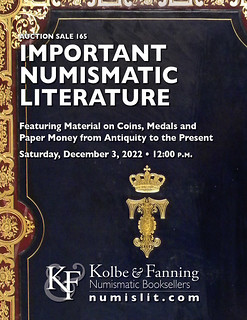 Kolbe & Fanning Numismatic Booksellers will be holding an auction sale this Saturday, December 3, 2022, beginning at 12:00 noon eastern time. The sale includes a wide variety of rare and out-of-print works on coins, medals, and paper money from antiquity to the present, and encompasses consignments from around the world. Some highlights of the sale include:
Kolbe & Fanning Numismatic Booksellers will be holding an auction sale this Saturday, December 3, 2022, beginning at 12:00 noon eastern time. The sale includes a wide variety of rare and out-of-print works on coins, medals, and paper money from antiquity to the present, and encompasses consignments from around the world. Some highlights of the sale include:
NEW BOOK: THE EARLY BETTS MEDAL COMPANION
As noted a few weeks ago, Chris McDowell has written a new book on Betts medals, and it's now available from the ANS for preorder. Here's the announcement. -Editor
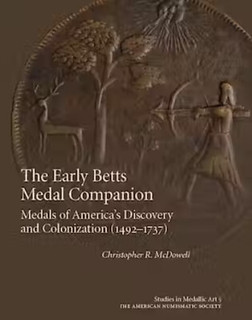 The American Numismatic Society (ANS) is pleased to announce the publication The Early Betts Medal Companion: Medals of America’s Discovery and Colonization (1492–1737), the fifth volume in the Society’s Studies in Medallic Art series.
The American Numismatic Society (ANS) is pleased to announce the publication The Early Betts Medal Companion: Medals of America’s Discovery and Colonization (1492–1737), the fifth volume in the Society’s Studies in Medallic Art series.
Authored by Christopher R. McDowell—ANS Fellow, editor of the Journal of Early American Numismatics, and President of the Colonial Coin Collectors Club (C4)—this book brings to fruition the dream of nineteenth-century numismatist Charles Wyllys Betts to illustrate American colonial history through contemporary medals. Focusing on medals from the period of discovery through the period of colonization of the New World, McDowell’s volume is a companion to Betts’s masterpiece, American Colonial History Illustrated by Contemporary Medals. This is the first of what is expected to be three volumes by McDowell concerning Betts medals.
NEW BOOK: INTERPRETING EARLY MEDIEVAL COINAGE
The British Numismatic Society has published a festschrift for Stewart Lyon. -Editor
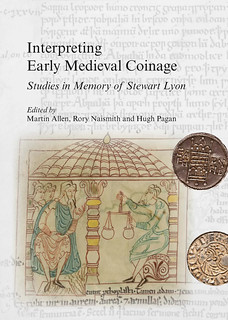 Interpreting Early Medieval Coinage. Essays in Memory of Stewart Lyon
Interpreting Early Medieval Coinage. Essays in Memory of Stewart Lyon
British Numismatic Society Special Publication No. 15
Edited by Martin Allen, Rory Naismith and Hugh Pagan
£45.00
Over a period of some sixty-five years, Stewart Lyon (1926–2021) brought an exceptional quality of intellect and a deep engagement to the study of Anglo-Saxon and related coinages. This volume represents a tribute to his achievement. It assembles the work of thirteen established and rising scholars of early medieval numismatics and allied disciplines. Their work includes up-to-date surveys, the results of detailed research and discussions of important new finds, all selected to complement the interests of Stewart himself. The coverage ranges widely chronologically and geographically, from the collapse of Roman Britain to the twelfth century, and from Whitby to Wales and Normandy. Taken as a whole, the essays in this book represent both a celebration of Stewart’s memory, and an assemblage of scholarship of lasting significance for all those interested in the coinage of medieval Britain. The volume concludes with a bibliography of Stewart Lyon’s publications.
NEW BOOK: SASANIAN COINS
Bagchee, a book store in New Delhi, India is offering a new book on Sasanian coins. It's a compendium of reprinted articles on the topic. -Editor
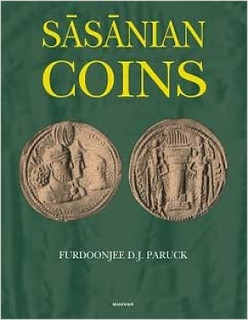 Sasanian Coins
Sasanian Coins
Furdoonjee D.J. Paruck (Author)
Information on Sasanian numismatics has been published in journals of various societies across Europe, especially in France, Germany and Russia, but is not available in the form of books. Sasanian numismatics has been under-represented in the English literature on coins. This has posed a serious challenge for those who have acquired Sasanian-era coins as well as those who seek them, as they do not have a source of reference to turn to for guidance and assistance. This is because despite the importance of this subject, no effort has been made to publish a comprehensive and collected account of Sasanid coinage, and the information that is available is largely scattered.
DOUGLAS EARL SPANGLER JR. (1946-2022)
Mark Fox of Michigan submitted this remembrance of ancient coin dealer and collector Doug Spangler. Thank you. -Editor
A Big Deal in Small Coin Dealing:
Douglas Earl Spangler Jr. (1946–2022)
by Mark Fox
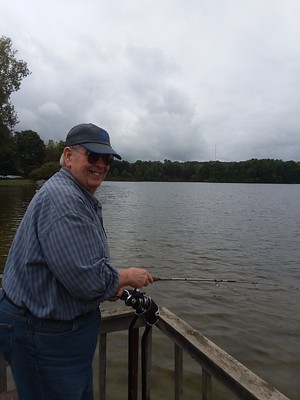 It is with a very sad heart that I announce the passing of Doug Spangler on the morning of November 22, after battling Alzheimer’s for several years. He was seventy-five and born on December 27, 1946, in Cleveland, Ohio. Who is Doug, one might ask? With his wife Carol of fifty-three years in marriage (who ever so gently broke the news to me), they are, simply put, a pair of small-time ancient coin dealers whose contagious kindness and friendliness make this hobby worth enjoying and life worth living.
It is with a very sad heart that I announce the passing of Doug Spangler on the morning of November 22, after battling Alzheimer’s for several years. He was seventy-five and born on December 27, 1946, in Cleveland, Ohio. Who is Doug, one might ask? With his wife Carol of fifty-three years in marriage (who ever so gently broke the news to me), they are, simply put, a pair of small-time ancient coin dealers whose contagious kindness and friendliness make this hobby worth enjoying and life worth living.
According to my records, my first coin purchase from them was on eBay, in March of 2014, and consisted of an ancient Greek bronze purportedly issued by Carystus on the island of Euboea. This city’s coinage was on my mind a lot back then (which involves a different story), so I was glad to finally snag a piece. Later on, however, I realized that it was actually an issue of Dicaea (Dikaia) in Thrace, a coin type that is confused notoriously often with its Carystian counterpart, right down to the positioning of two of the letters on the reverse! I told Doug about my discovery several months later, in December, and in spite of the long lapse in time, he wanted to take the coin back and make things right. I told him that I didn’t mind holding on to the “pseudo-Carystus” specimen since it was still a rare coin and a type unrepresented in my collection. (Let’s be honest: when it comes to numismatics, I am not very fussy. If I buy a beaten up LRB for $5 and it was found to be misidentified, but worth a million dollars, I will probably still keep it, assuming inflation eases a bit.)
MORE ON THE CARNEGIE COLLECTION
Newman Numismatic Portal Project Coordinator Len Augsburger provided the following report in the 1980s Carnegie Museum sales. Thanks. -Editor
More on the Carnegie Collection
Last week Alan Weinberg noted the sale of portions of the Carnegie Museum of Natural History collection. Spink & Son USA sold a number of deaccessioned items on September 14, 1982, which consisted of United States silver dollars from the Carnegie collection (lots 331-429). Highlights include a set of proof Trade dollars from 1873-1883, and a run of Morgan dollar proofs from 1878-1904, including many duplicates as well as the rare 1895 issue (realized $9,500), which served as the catalog cover plate coin. The 1921 Zerbe proof is also present. Highlights from earlier pieces include a 1794 dollar in VG/F (realized $12,500), an 1836 Gobrecht dollar, an 1865 Seated dollar with motto (Judd-434, realized $4,500) and a Mint State 1872-CC example (realized $3,750).
VIDEO: CHESTER KRAUSE
The David Lisot Video Library on the Newman Numismatic Portal can be found at:
https://nnp.wustl.edu/library/multimediadetail/522852
We highlight one of his videos each week in The E-Sylum. Here's one from 1986 with Krause Publications founder Chet Krause. Numismatic history, directly from the man who made it. -Editor
THE BOOK BAZARRE
MORE ON THE TREATY OF PARIS MEDAL
Peter Jones submitted these thoughts on the Treaty of Paris medal. Thank you! -Editor
I read with interest Jeremy Bostwick's listing of the Betts 610 Treaty of Paris/Peace of Versailles medal in white metal in The E-Sylum. The medal is interesting for a number of reasons.
RESPONSE TO THE "FRANKLIN CENT" ARTICLE
Craig Sholley submitted these comments in reaction to the piece last week on the Fugio Cent. -Editor
Craig Sholley
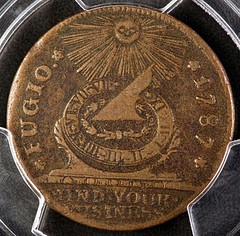 I read the most interesting article on Benjamin Franklin designing the Fugio (or Franklin) cent in
the November 20th issue of The E-Sylum. In fact, I found it so captivating that I had to click on
the link and read the full article. What a charming tale. I have just one small issue with the
story – it’s simply not true.
I read the most interesting article on Benjamin Franklin designing the Fugio (or Franklin) cent in
the November 20th issue of The E-Sylum. In fact, I found it so captivating that I had to click on
the link and read the full article. What a charming tale. I have just one small issue with the
story – it’s simply not true.
Aside from designing the thirteen interlocking rings motif which was copied from Continental currency and modified for use on a coin, Franklin had no connection whatsoever to the Fugio cent. He most certainly did not design it and he most certainly had nothing to do with establishing the weight standard.
How did this myth spring up? The term “Franklin Cent” dates to at least the mid-19 th century, and likely much earlier. It was in common use by 1859 as John K. Curtis’ fixed price list of that year offered “Franklin Cents” for sale at 25 cents to $1.50. The term was also used in auction catalogs by W. Elliot Woodward, Edward Cogan, and others from 1860 on. Since dealers and auctioneers were using it, the term had obviously been in common use for some time.
NOTES FROM E-SYLUM READERS: NOVEMBER 27, 2022
Young America Furnace Company Note Signer
In 2017 we discussed a group of three rare obsolete notes from the Young America Furnace Company of Petrea, Ohio. Dave Schenkman had provided the images. The firm was in business circa 1856-1860. -Editor
"The signature on the notes is that of my great great grandfather, James H C Miller. I was just digging up info on the furnace and happened upon your site. Thank you for posting the images. After decades of living in New York State, I find myself wandering the hills of southeastern Ohio where I grew up, digging into family history."
Thanks for letting us know! It's great to hear we've been able to connect someone with their family history. This is why we post articles online - one never knows where or when the information will be useful again. I put Brian in touch with Dave, who sent him a copy of his article on the notes in Paper Money, published by the Society of Paper Money Collectors.
QUICK QUIZ: what word on the note is misspelled? -Editor
To read the earlier E-Sylum articles, see:
WAYNE'S NUMISMATIC DIARY: MAY 14, 2017 : Young America Furnace Company Notes
(https://www.coinbooks.org/v20/esylum_v20n20a17.html)
NOTES FROM E-SYLUM READERS: MAY 21, 2017 : More on the Young America Furnace Company Notes
(https://www.coinbooks.org/v20/esylum_v20n21a13.html)
Other topics this week include Bookbinder Recommendations, U.S. Mint nonsense coins, and the 1989 Pittsburgh ANA Coin Drop. -Editor
HERMON MACNEIL PLASTERS MOVE COMPLETED
As mentioned a couple weeks ago, James Haas and a crew of helpers transported several plasters of Hermon Atkins MacNeil's works to a new home. It was MacNeil who modeled the Standing Liberty Quarter and other numismatic products. Here's his report on the historic trip. Thanks! -Editor
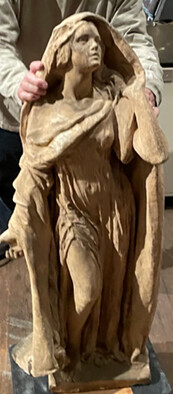 The August, 1917 issue of the The American Architect included an article titled “Waste in Art”.
The writer quoted Hermon Atkins MacNeil’s recent address before the American Federation of Arts
during which he suggested the establishment of a gallery in Washington where plaster casts of the
best American work in sculpture could be permanently assembled for the purpose of study. The
Sculpture Gallery in the City Art Museum in St. Louis had collected “a handsome collection by
securing sculptors’ plasters that had served their purpose. While these represented works that totaled
more than a million dollars, they were acquired practically without cost.
The August, 1917 issue of the The American Architect included an article titled “Waste in Art”.
The writer quoted Hermon Atkins MacNeil’s recent address before the American Federation of Arts
during which he suggested the establishment of a gallery in Washington where plaster casts of the
best American work in sculpture could be permanently assembled for the purpose of study. The
Sculpture Gallery in the City Art Museum in St. Louis had collected “a handsome collection by
securing sculptors’ plasters that had served their purpose. While these represented works that totaled
more than a million dollars, they were acquired practically without cost.
Fast forward to October 1948 when the Corcoran Gallery of Art in Washington D.C. decided to clean up its cellar. By offering its collection of 60 plasters to the District schools, students were provided the opportunity to study great works of art. Many were scooped up.
In the spring of that year, the Sheldon Swope Gallery in Terre Haute, IN had asked for some, perhaps inspired by its recent gift of eighteen of MacNeil’s plaster models donated by his widow, Cecelia Muench MacNeil. The works were put in storage where they remained for the next 75 years.
RIDDELL’S NOTES ON THE NEW ORLEANS MINT
One of the highlights of the upcoming Kolbe & Fanning December 2022 numismatic literature sale is a rare edition of Riddell’s Notes on the New Orleans Mint. -Editor
Extremely Rare Illustrated 1847 Second Edition of Riddell’s Notes on the New Orleans Mint
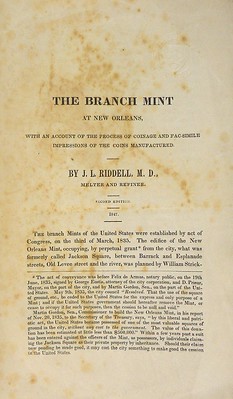 382 Riddell, J.L. THE BRANCH MINT AT NEW ORLEANS, WITH AN ACCOUNT OF THE PROCESS OF COINAGE AND FAC-SIMILE IMPRESSIONS OF THE COINS MANUFACTURED. No publisher imprint. Second edition, 1847. 8vo, original plain yellow paper covers. 10 pages; illustrations of both sides of eight coins (see comments). Foxed, particularly the blank covers; folded and somewhat wrinkled. Good. $2500
382 Riddell, J.L. THE BRANCH MINT AT NEW ORLEANS, WITH AN ACCOUNT OF THE PROCESS OF COINAGE AND FAC-SIMILE IMPRESSIONS OF THE COINS MANUFACTURED. No publisher imprint. Second edition, 1847. 8vo, original plain yellow paper covers. 10 pages; illustrations of both sides of eight coins (see comments). Foxed, particularly the blank covers; folded and somewhat wrinkled. Good. $2500
Only the second copy to have come to market of which we are aware. John Leonard Riddell (1807–1865) was Melter and Refiner at the New Orleans Mint from 1838 to 1849, and the author of A Monograph of the Silver Dollar, Good and Bad (1845), a classic work on the American dollar that remains useful to scholars today. Later in life, Riddell served as the New Orleans Postmaster during the pivotal period of secession and the outbreak of the Civil War. He also published two editions of his account of operations at the New Orleans Mint.
VOCABULARY TERM: MEDAL COLLECTING
Here's another entry from Dick Johnson's Encyclopedia of Coin and Medal Terminology - a wonderful discussion of medal collecting. The list of medal collections in American museums is extremely useful, although dated - it includes the Baker Collection at the Historical Society of Pennsylvania, now deaccessioned but largely recreated at the American Numismatic Association due to Dwight Manley's efforts. -Editor
Medal Collecting. Acquiring and bringing together a number of medallic specimens of some related theme, as a topic or thematic. Unlike coin collecting, which is dominated by dates and mintmarks within series, at least in the United States, medal collecting is far more dramatic. It encompasses a universe of varying designs, larger sizes, higher relief, more artistic treatment, far more topics to collect, and better condition of specimens (since, unlike coins, medals do not abrade by circulating). Once only royal families collected medals, exchanging gift medals among themselves. Today medal collecting can be enjoyed by people of all walks of life. However, it does require immense curiosity and a strong intellect for the art and history that medal collecting entails.
EZRA HILL (1838-1860)
American Numismatic Biographies author Pete Smith submitted this article on a very early and very young numismatist named Ezra Hill. Thanks! -Editor
This week I went on a quest to construct a biography for Ezra Hill. He is noted as a founding member of the American Numismatic Society in 1858 but not traced after 1860. The quest took me to some surprising places.
On the evening of April 6, 1858, a dozen men (and boys) gathered at the home of Augustus B. Sage for the first official meeting of the American Numismatic Society. Signing in just ahead of Sage was Ezra Hill who gave his address as 248½ Bowery. This is a few blocks west of the Sage apartment at 121 Essex Street in New York City. Sage was born on May 13, 1841, and would have been short of his seventeenth birthday. Ezra Hill would have been 19 or 20.
I wonder how this group found each other. Sage probably developed his interest in numismatics around age fifteen. Hill would not have attended the meeting if he did not have an interest prior to 1858. It is possible that one connection was John K. Curtis with a shop at 83 Bleecker Street. That puts him two blocks northwest of Hill’s later store at 6 Bleecker Street.
A PHOTOGRAPH OF JULES FONROBERT
Julia Casey submitted these research notes and a newly discovered photo of collector Jules Fonrobert. Thanks! -Editor
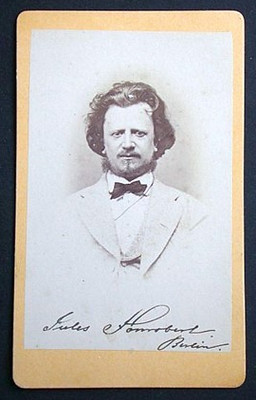 I came across this portrait photograph of Jules Fonrobert, a Berlin “felt factory owner.” I believe this to be the same Jules Fonrobert whose famous collection was sold by Adolph Weyl c. 1878-1879. The website (“The History of Berlin”) lists a date of death of 1895, but I am inclined to think this is an error. Numismatic researchers have found an 1879 obituary for Fonrobert, and while the photograph may be of another Jules Fonrobert, I think it is the same individual as the coin collector, and the 1895 death date is mistaken.
I came across this portrait photograph of Jules Fonrobert, a Berlin “felt factory owner.” I believe this to be the same Jules Fonrobert whose famous collection was sold by Adolph Weyl c. 1878-1879. The website (“The History of Berlin”) lists a date of death of 1895, but I am inclined to think this is an error. Numismatic researchers have found an 1879 obituary for Fonrobert, and while the photograph may be of another Jules Fonrobert, I think it is the same individual as the coin collector, and the 1895 death date is mistaken.
Fonrobert’s obituary was translated for The E-Sylum in 2013 by Ralf W. Böpple, with further commentary by Bob Leonard.
In addition, I found a baptismal record for Jules Fonrobert confirming a September 4, 1831, date of birth. His full name on this record is Charles Julian Francois Fonrobert. However, I have seen his name listed in different ways i.e. Charles F.J. Fonrobert, Charles Francois Jules Fonrobert, and Karl Julius Franz Fonrobert. I would be interested in any feedback from E-Sylum readers!
COUNTERFEIT TRAINING GIVEN TO LAW OFFICERS
This press release from the Anti-Counterfeiting Educational Foundation (ACEF) describes a recent seminar for law enforcement officers. Great endeavor, and nice turnout! -Editor
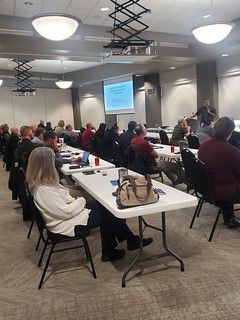 The Anti-Counterfeiting Educational
Foundation recently conducted an eight-hour class, “Counterfeit
Coin and Precious Metals Investigations” to 35 Kansas and Missouri local, state and
federal law enforcement investigators. Participants in the ACEF seminar were shown
examples of fake numismatic items during the training session held in the Kansas City
suburb of Mission, Kansas.
The Anti-Counterfeiting Educational
Foundation recently conducted an eight-hour class, “Counterfeit
Coin and Precious Metals Investigations” to 35 Kansas and Missouri local, state and
federal law enforcement investigators. Participants in the ACEF seminar were shown
examples of fake numismatic items during the training session held in the Kansas City
suburb of Mission, Kansas.
“This educational program is one of the many strategic initiatives of ACEF to address the mass proliferation of counterfeit coins and precious metals within the U.S. marketplace,” said seminar co-presenter Doug Davis, ACEF Director of Anti-Counterfeiting.
THE BOOK BAZARRE
NGC INTRODUCES 10-POINT COIN GRADING SCALE
You've all probably seen this news elsewhere by now, but I wanted to include this press release and ask for some reader comments. While we generally don't discuss coin grading or pricing, major changes at the grading companies are hobby history in the making. We reported earlier on ownership changes and the ascent of sports card traders, with John Feigenbaum noting "that rare coins are clearly taking a back seat to sports cards." -Editor
A path to growth for coin collecting, the new 10-point grading scale will supplement the 70-point Sheldon scale, which will continue to be used by NGC.
Numismatic Guaranty Company™ (NGC®) is excited to introduce NGCX, the first 10-point grading scale for coins. The 10-point grading scale has long been the standard for most collectibles, including comic books, sports cards, trading cards and more. Now, with NGCX, coin collecting will benefit from the same intuitive and approachable scale.
WORLD BANKNOTE AUCTIONS SALE 35
Here's the announcement for the upcoming World Banknote Auctions Sale 35. -Editor
World Banknote Auctions has now launched Live Sale 35 at www.worldbanknoteauctions.com. Live Sale 35 takes place on December 1, 2022, with live bidding that day at 1 PM Eastern / 10 AM Pacific. Please note that Sale 35 is divided in two parts, each selling on a different day. The first live session with 505 lots takes place on December 1 at 10 AM PST. The second session with 486 lots closes on December 4 at 3 PM PST (special bidding rules apply for the timed sale, please see our website for details). Our bidding platform can be accessed directly by going to bid.worldbanknoteauctions.com or through our mobile apps.
World Banknote Auctions will host sales with live internet bidding every 3 weeks. Bidding for all items starts at just $10 and there is a buyer’s premium of just 15% (with a minimum of $10 per lot), 25% less than the industry average. Shipping rates are flat for most items, with shipping within the United States for just $15 and overseas shipping at $30.
NUMISMATIC NUGGETS: NOVEMBER 27, 2022
Here's a selection of interesting or unusual items I came across in the marketplace this week. Tell us what you think of some of these. -Editor
A GEORGE III GOLD HALF GUINEA TOKEN, 1812, by Younge & Wilson of Sheffield, EF, 3.2g, with Royal Mint certificate (Illustrated) (Est. plus 21% premium inc. VAT)
The plain obverse reminds me of the U.S. gold rush Bechtler coinage. -Editor
To read the complete lot description, see:
A GEORGE III GOLD HALF GUINEA TOKEN, 1812, by Younge & Wilso...
(https://www.easyliveauction.com/catalogue/lot/
6d3701b99b45cbcfc01c9c013f7b2321/0af8d24542e81eb9357e7ef448a6646f/
winter-antiques-interiors-auction-lot-323/)
Other topics this week include an 1817 James Monroe Indian Peace Medal, and a 1909 Alaska-Yukon-Pacific Expo Gold Token. -Editor
COIN OF SPONSIAN IS GENUINE. OR IS IT?
A coin in the Hunterian museum in Glasgow, long thought to be fake, has been declared genuine, but not everyone is convinced. -Editor
A forgotten Roman emperor has been saved from obscurity as a coin long thought to be fake has finally been authenticated.
The coin, unearthed 300 years ago, depicted a leader named Sponsian who was in power during the 260s AD.
It was believed to be a forgery, as it differed from both the manufacture process and general style of Roman coins from the time.
MEDIEVAL COIN HOARD FOUND IN SCOTLAND
A hoard of medieval Scottish, English, Irish and other silver coinage has been found in Scotland. -Editor
Thousands of coins dating back to the 13th and 14th centuries were discovered by metal detectorists buried near Dunscore.
A spokesperson for the Treasure Trove Unit – which is responsible for logging new archaeological finds and preserving them for the public good – said it is one of the largest medieval coin hoards found in Scotland since the 19th century.
CELTIC TREASURE COINS STOLEN IN GERMANY
Arthur Shippee passed along this story of a Celtic coin heist in Germany. -Editor
Thieves who broke into a southern German museum and stole hundreds of ancient gold coins got in and out in nine minutes without raising the alarm, officials said Wednesday, in a further sign that the heist was the work of organized criminals.
Police have launched an international hunt for the thieves and their loot, consisting of 483 Celtic coins and a lump of unworked gold that were discovered during an archeological dig near the present-day town of Manching in 1999.
AUSTRALIAN VICTORIA CROSS AWARDS SOUGHT
Last week we discussed a movement in Canada calling for the country to award Victoria Cross medals. While many had been awarded in WWII, none had been awarded since the selection process moved from the British monarchy to the Canadian government. It turns out Australia has a similar problem. Here's an article from The Spectator Australia - a number of WWII heroes are being promoted for Auatralia's VC. -Editor
 Imagine today if every approval for an Australian gallantry award had to be ticked off by someone in London. That was the case in World War II. That was what our Navy had to endure. The other two forces had their awards approved in Australia. Navies take a long time to grow, and ours had been ‘parented’ by the RN. When war arrived, there was no time for revision. Fighting for its life against Germany and Italy, and later Japan, Britain was understandably under extreme pressure.
Imagine today if every approval for an Australian gallantry award had to be ticked off by someone in London. That was the case in World War II. That was what our Navy had to endure. The other two forces had their awards approved in Australia. Navies take a long time to grow, and ours had been ‘parented’ by the RN. When war arrived, there was no time for revision. Fighting for its life against Germany and Italy, and later Japan, Britain was understandably under extreme pressure.
Perhaps due to that, there are at least four WWII naval personnel who could have received a VC. Some received what was called a ‘Mention in Despatches’, not a medal, rather a badge, albeit a prestigious one. Many thousands of Aussies were awarded a MID before it was phased out in 1975. But some of the bravest Navy personnel received no recognition whatsoever.
WINNIPEG 'IF DAY' PROPAGANDA NOTES
The Bank of Canada Museum blog has a nice article about "The Day Winnipeg Was Invaded." Not really, but cool story. -Editor
Winnipeg is famous for its cold winter weather. But on the morning of February 19, 1942, Winnipeggers were not concerned about how cold it was at Portage and Main. They woke up to the wailing of air-raid sirens and a total blackout. Winnipeg was being invaded! About 3,800 German-uniformed soldiers had taken over the city.
But Germany never invaded Canada. The extent of the military threat in Canada during the Second World War was the sighting of German U-boats in the St. Lawrence River. No German soldier ever set foot on Canadian soil as part of an invading force. Yet, on that day, Winnipeggers would have begged to differ.
NIGERIANS UNIMPRESSED WITH NEW BANKNOTES
There's a kerfuffle in Nigeria over newly introduced banknotes. -Editor
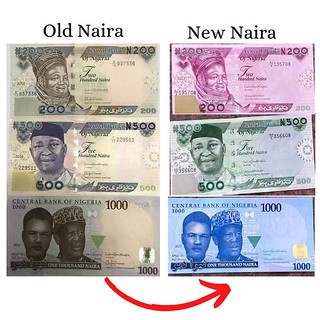 Nigerians have criticized the “redesigning” of the country’s local currency proposed by its central bank to rein in counterfeiting and hoarding of large sums outside the banking system.
Nigerians have criticized the “redesigning” of the country’s local currency proposed by its central bank to rein in counterfeiting and hoarding of large sums outside the banking system.
President Muhammadu Buhari unveiled the redesigned 200-, 500-, and 1,000-naira notes on Wednesday, saying “the new Naira banknotes have been fortified with security features that make them difficult to counterfeit.”
The new notes look very similar to those currently in circulation. The design of the highest-value 1,000-naira note, which includes the national coat-of-arms and the headquarters of the Central Bank of Nigeria, is largely unchanged. The only significant difference is the color — it’s gone from a largely brown underprint to blue.
MAN PAYS LAWYER WITH ANCIENT COIN
A man in Natchitoches, Louisiana paid his lawyer with a Hadrian Denarius. Here's an article from the Natchitoches Times. -Editor
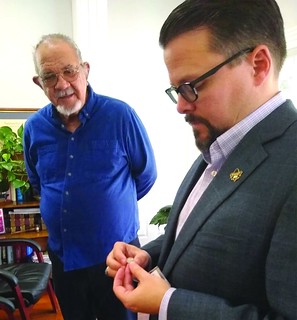 When Natchitoches resident Joe Darby needed a legal document revised recently, he agreed to pay attorney Eddie Harrington with a form of currency that doesn’t see much circulation these days: a coin dating to the Roman Empire. “In effect, I am paying for legal services with a 1,900 year-old coin,” says Darby. “It’s a silver denarius.” Darby is a history enthusiast, as is Harrington, so their meetings typically delve into topics in history. “Every time we meet for business, we end up talking history 80% of the time and business 20% of the time,” says Darby. “We exchange history books and things like that, so we’ve got that common interest.”
When Natchitoches resident Joe Darby needed a legal document revised recently, he agreed to pay attorney Eddie Harrington with a form of currency that doesn’t see much circulation these days: a coin dating to the Roman Empire. “In effect, I am paying for legal services with a 1,900 year-old coin,” says Darby. “It’s a silver denarius.” Darby is a history enthusiast, as is Harrington, so their meetings typically delve into topics in history. “Every time we meet for business, we end up talking history 80% of the time and business 20% of the time,” says Darby. “We exchange history books and things like that, so we’ve got that common interest.”
Darby is also a numismatist, a collector of coins, so when he stopped in to ask Harrington about updating the legal document, their conversation drifted to a coin Darby had added to his collection. “I showed him my latest acquisition, which was a coin minted in the reign of Caesar Augustus, the first Roman Emperor,” he says. “(He’s) not to be confused with Julius Caesar; that was his uncle.”
LOOSE CHANGE: NOVEMBER 27, 2022
Here are some additional items in the media this week that may be of interest. -Editor
CoinsWeekly published a short bio of Texas radio pioneer Gordon McLendon, a collector of ancient Greek and Roman coins. It was originally published in a Numismatica Ars Classica catalog. -Editor
To read the complete article, see:
Gordon McLendon (1921-1986)
(https://coinsweekly.com/whoswho-sammler/mclendon-gordon-1921-1986/)
Other topics this week include the invention of national banks. -Editor
THANKSGIVING AND THE U.S. MINT
Readers may not realize it, but there's a connection between Thanksgiving and the U.S. Mint. -Editor
Everyone knows the story of the first Thanksgiving – in November 1621, the newly-arrived Pilgrims convened with the Wampanoag natives to celebrate an autumnal harvest celebration, later dubbed Thanksgiving. But how did Thanksgiving transform into the national tradition we know and love today?
FEATURED WEBSITE: HERMON A. MACNEIL
This week's Featured Web Site is about sculptor Hermon Atkins MacNeil.
WELCOME TO THE “HERMON A. MACNEIL” — VIRTUAL GALLERY & MUSEUM !
This Gallery celebrates Hermon Atkins MacNeil, of the Beaux Arts School American classic sculptor of Native images and American history. ~ World’s Fairs, statues, monuments, coins, and more… ~ Hot-links lead to works by Hermon A. MacNeil. ~ Over 200 of stories & 2,000 photos form this virtual MacNeil Gallery stretching east to west New York to New Mexico ~ Oregon to S. Carolina. ~ 2021 marks the 155th Anniversary of Hermon MacNeil’s birth. ~~Do you WALK or DRIVE by MacNeil sculptures DAILY! ~~ CHECK it OUT!
